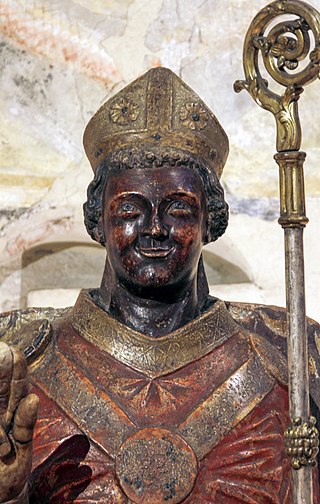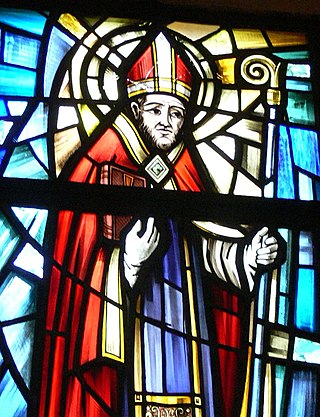
Amiternum was an ancient Sabine city, then Roman city and later bishopric and Latin Catholic titular see in the central Abruzzo region of modern Italy, located 9 km (5.6 mi) from L'Aquila. Amiternum was the birthplace of the historian Sallust.

Denis of France was a 3rd-century Christian martyr and saint. According to his hagiographies, he was bishop of Paris in the third century and, together with his companions Rusticus and Eleutherius, was martyred for his faith by decapitation. Some accounts placed this during Domitian's persecution and incorrectly identified St Denis of Paris with the Areopagite who was converted by Paul the Apostle and who served as the first bishop of Athens. Assuming Denis's historicity, it is now considered more likely that he suffered under the persecution of the emperor Decius shortly after AD 250.

The Sanctuary of Saint Michael the Archangel is a Roman Catholic shrine on Mount Gargano, Italy, part of the commune of Monte Sant'Angelo, in the province of Foggia, northern Apulia. It has the dignity of a minor basilica.

Pescara is the capital city of the province of Pescara, in the Abruzzo region of Italy. It is the most populated city in Abruzzo, with 118,657 residents. Located on the Adriatic coast at the mouth of the River Aterno-Pescara, the present-day municipality was formed in 1927 joining the municipalities of the old Pescara fortress, the part of the city to the south of the river, and Castellamare Adriatico, the part of the city to the north of the river. The surrounding area was formed into the province of Pescara.

The province of Pescara is a province in the Abruzzo region of Italy. Its capital is the city of Pescara, which has a population of 119,483 inhabitants. As of 2017, it has a total population of 319,936 inhabitants over an area of 1,230.33 square kilometres (475.03 sq mi). The provincial president is Antonio Zaffiri and the province contains 46 comuni.

Zeno of Verona was an Afro-Italian Christian figure believed to have either served as Bishop of Verona or died as a martyr. He is venerated as a saint in the Catholic Church and the Orthodox Church.

According to legend, Rufinus of Assisi, was the first bishop of this city and a martyr.

Saint Lucian of Beauvais is a Christian martyr of the Catholic Church, called the "Apostle of Beauvais." He was killed in the 3rd century during the Diocletian persecution, although later traditions make him a martyr of the 1st century instead. This was because the church of Beauvais attempted to claim apostolic origins for itself. Odo, bishop of Beauvais during the 9th century, was the first writer to designate Lucien as the first bishop of Beauvais.

Saint Himerius of Bosto is venerated as a pilgrim and martyr. He is venerated in the province of Varese jointly with Gemolus (Gemolo), who was martyred with him.
Barbatus of Benevento, also known as Barbas, was a bishop of Benevento from 663 to 682. He succeeded Ildebrand in this capacity. He assisted in a church council called by Pope Agatho in Rome in 680 and in 681 attended the Third Council of Constantinople against the Monothelites.

In Christianity, the translation of relics is the ceremonial removal of holy objects from one place to another. Usually only the movement of the remains of a saint's body would be treated so formally, with secondary relics such as items of clothing treated with less ceremony. Translations could be accompanied by many acts, including all-night vigils and processions, often involving entire communities.

Cerbonius was a bishop of Populonia during the Barbarian invasions. Pope Gregory I praises him in Book XI of his Dialogues.
Saint Edistus is venerated as a martyr and saint by the Roman Catholic and Eastern Orthodox churches. His legend states that he was martyred on the Via Laurentina and his passio places his martyrdom during the reign of Nero, on October 12, 60 AD.

Saint Gaudentius was a bishop of Novara, considered the first of that city. Tradition states that he was born to a pagan family at Ivrea, and was then converted to Christianity by Eusebius of Vercelli. Some sources say that Eusebius ordained Gaudentius a priest, and that Gaudentius was sent to Novara by Eusebius to assist a Christian priest named Laurence (Laurentius) there.

Saint Justus of Trieste is a saint venerated in the Eastern Orthodox Church and Roman Catholic Church.

Pescara Cathedral is a Roman Catholic cathedral in the Via D'Annunzio in the city of Pescara. The cathedral, dedicated to Saint Cetteus, patron saint of Pescara, has been the seat of the Archbishop of Pescara-Penne since the creation of the archdiocese in 1982. The present Romanesque Revival building, originally called the Tempio della Conciliazione, was constructed in the 1930s, replacing the medieval church of San Cetteo.
Saint Crispoldus is venerated as a 1st-century Christian martyr. He is the patron saint of Bettona, in Umbria, and said to have been the first bishop of that city, although the dioceses of Nocera and Foligno also include his name in episcopal lists.
Pontianus was a second century Christian martyr. He was martyred during the reign of the Emperor Marcus Aurelius. He is honored as a saint and martyr by the Catholic Church, the Old Catholic Church, and the Eastern Orthodox Church. In Spoleto, Italy, he is invoked for protection against earthquakes.

Luxurius or Luxorius was an ancient Roman official on Sardinia in the late 3rd and early 4th centuries. Apparitor to Delphius, the praeses or governor of the island, he was converted to Christianity by reading the Psalms. He possibly was beheaded on 21 August for refusing to sacrifice to idols in the city of Forum Traiani, probably in 304 during the fourth of Diocletian's persecutions. Later he was venerated as a martyr and saint by the Roman Catholic Church.

Cassius and Castus were two African bishop-martyrs, particularly venerated in Benevento, Calvi, Capua, Sora, Gaeta and other nearby towns in Campania and Lazio. Their feast day is 22 May, shared with Castus and Emilius.
















